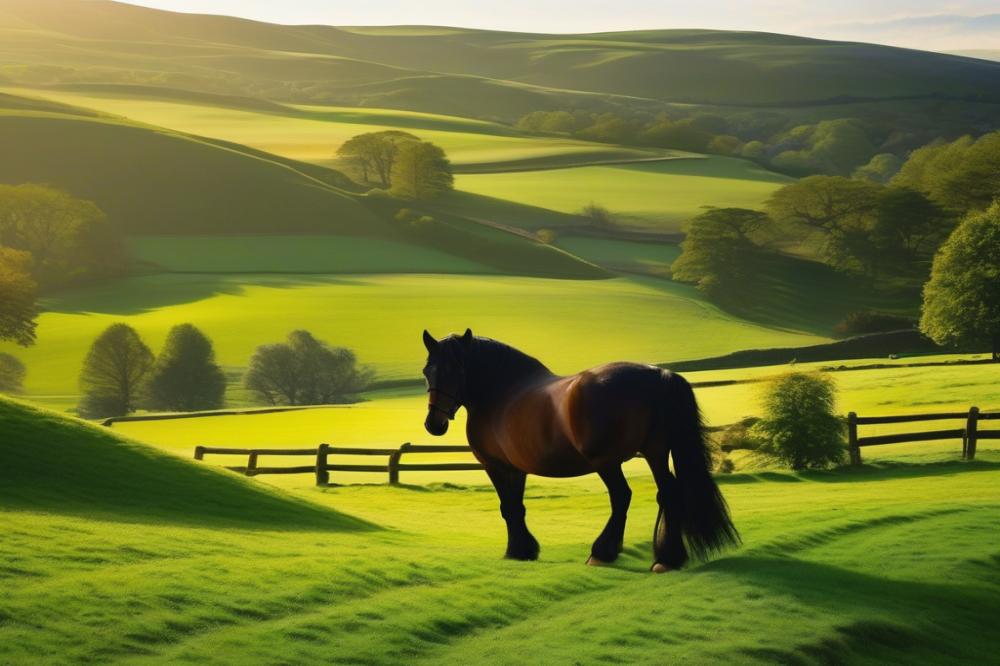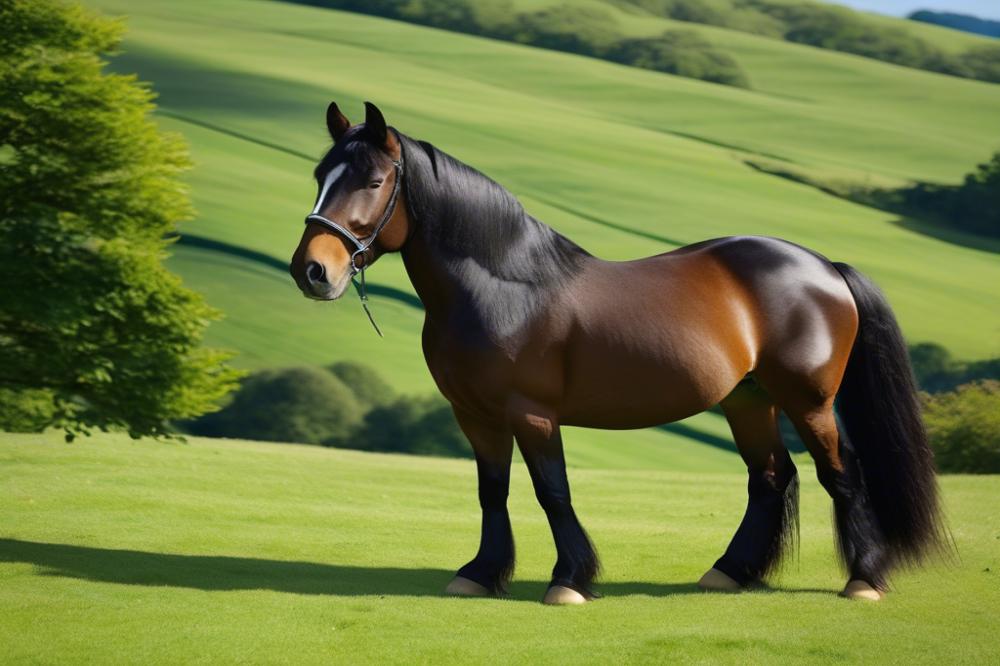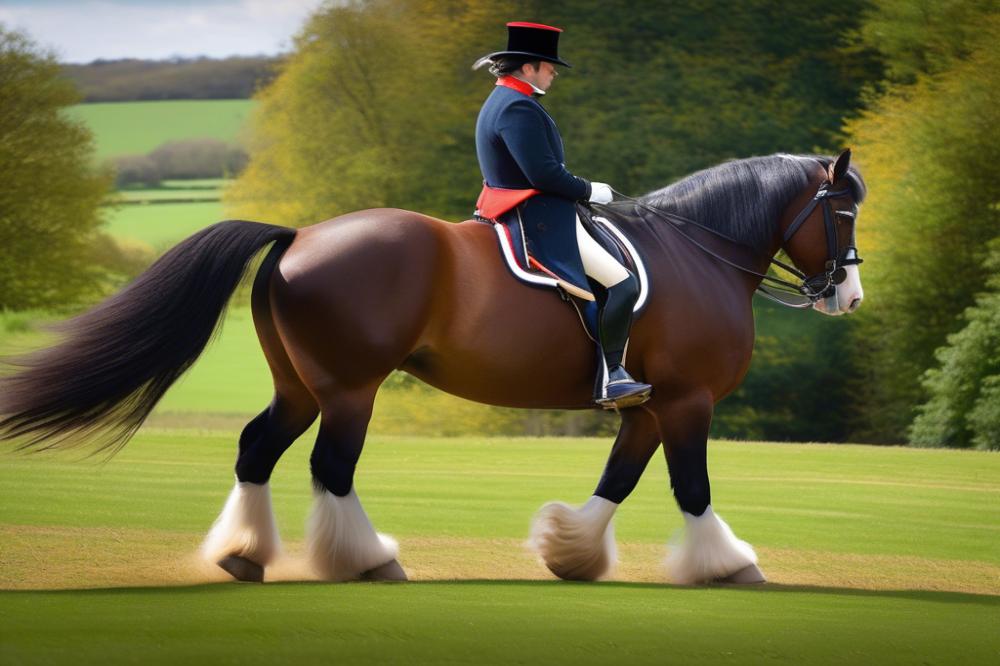Introduction
Shire horses are among the largest and most majestic breeds in the equine world. Their powerful build and gentle temperament make them popular for various activities, including heavy draft work and leisure riding. Enthusiasts admire these horses for their calm demeanor and intelligence. When it comes to riding on open terrain, special techniques are necessary to maximize comfort and safety for both rider and horse.
Understanding the importance of proper riding techniques is crucial, especially with such a significant animal. Riders must be aware of their Shire horse‘s capabilities and limitations. This knowledge not only enhances the riding experience but also fosters a deeper bond between horse and rider. Many factors come into play during open terrain riding, including the landscape, weather conditions, and the horse’s condition. Each of these elements can impact the ride significantly.
This article breaks down effective methods designed specifically for Shire horse riding. Readers will learn how to prepare for rides, manage their horse in diverse terrains, and navigate essential safety strategies. By the end, you will be equipped with the insights needed for enjoyable and safe adventures with your Shire horse. Prepare to explore the best techniques that can make your time on open terrain rewarding and enjoyable!
Understanding the Shire Horse

Characteristics of Shire Horses
Shire horses are among the largest horse breeds in the world. Known for their impressive size, they can weigh over 1,800 pounds and stand around 16 to 18 hands tall. These gentle giants possess a calm demeanor, making them approachable and friendly. Their dense build and strong bones contribute to their overall robustness. Often, Shire horses have feathering on their lower legs, giving them a distinctive look. This breed is also recognized for its short back and powerful haunches, which provide stability and strength.
Unique Traits Affecting Riding Style
Riding a Shire horse requires an understanding of their unique traits. Their size can intimidate some riders, but it’s important to focus on their gentle nature. Shires are not extremely agile. However, they can cover ground efficiently. Riders might need to adjust their expectations. Turns and quick movements may be less fluid compared to lighter breeds. Communicating clearly with the horse becomes essential to maintain harmony. Another aspect to consider is their temperament. Being less nervous, Shires often remain calm even in unfamiliar situations.
Importance of Size and Strength in Trail Riding
When it comes to trail riding, size and strength are significant advantages. These horses can handle rough terrains with ease. Their muscle mass allows them to carry heavy loads, which is especially beneficial on long rides. Riders can rely on their endurance, as Shires are known for their capability to work hard over extended periods. Having a sturdy horse provides confidence as you navigate unpredictable paths or steep hills. Such strength makes them ideal for anyone requiring a reliable partner in challenging conditions.
Essential riding techniques for Shire horse riding

Correct Riding Position for Comfort and Control
Maintaining the right posture is fundamental when riding a Shire horse. Your back should be straight, with shoulders relaxed. Keeping both heels down will provide stability. Sit deep in the saddle to maintain control. This position distributes your weight evenly. Balance is crucial, especially on uneven ground. Feet should rest in the stirrups comfortably. Avoid gripping too tightly with your knees. A relaxed hold allows for better communication with your mount.
Rein Handling and Communication with the Horse
Effective rein handling is key to a good riding experience. Hold the reins gently but firmly. Communication shouldn’t feel harsh; it should be subtle. Use your hands to guide your horse while maintaining a steady contact. A slight pull can indicate the direction you wish to go. Remember, consistency matters greatly. If you pull too hard, it could cause confusion. Always be aware of your horse’s reactions to your movements.
Influence of Weight Distribution on Performance
Weight distribution can have a big impact on how a Shire horse performs. Shires are large and powerful animals. Your weight should be centered over the horse’s midsection for optimum balance. Leaning too far forward or backward can disrupt its rhythm. Shift your weight gently when turning. This small adjustment helps your horse respond more effectively. When going up or down hills, lean slightly back to counteract the incline. Each of these actions requires attention and practice.
Terrain Management Skills

Riding a Shire horse across open terrain requires specific skills. First, assessing the type of terrain is crucial. Different surfaces have varying impacts on riding techniques. For instance, hard paths can create a jarring ride, while soft ground might result in sinking. Knowing these differences will help in preparation.
When navigating hills, shifting weight is essential. Leaning forward can help maintain balance on steep inclines. Going downhill requires careful body position as well. Sit back gently and use your legs for stability. Steep slopes can be tricky, so extra caution is advisable.
Valleys present another challenge. Changes in elevation require awareness of your horse’s footing. Smooth transitions can prevent stumbling. In addition, keeping pace with the terrain can help prevent fatigue. Rigid speeds may lead to harder impacts on uneven ground.
Flat land offers different opportunities for riding. Galloping might be tempting, but maintaining control is vital. Keep the reins loose yet guided to ensure your horse stays calm. Shire horses can be strong, so remaining aware of their energy level is helpful.
Varied surfaces such as grass, gravel, or mud also influence riding strategies. Each texture affects traction and speed. Riding in mud often means using slower, more deliberate movements. In contrast, packed dirt can allow for quicker maneuvers. Altering your approach based on the ground type will lead to a safer experience.
Practicing these skills will contribute to a more enjoyable ride. Familiarity with different terrains builds confidence for both horse and rider. Developing a keen sense of observation will greatly enhance your overall expertise when traversing the open landscape.
Riding Lessons Specific to Shire Horses
Tailoring lessons to the size and temperament of Shire horses is essential for effective riding. These gentle giants require a different approach compared to smaller breeds. Riders must adjust their techniques, considering the unique characteristics of these horses. Understanding their strengths and weaknesses can lead to a more enjoyable experience.
Foundational equestrian skills are necessary for anyone looking to ride these impressive animals. Learning proper mounting techniques is vital. This includes how to use the stirrups for balance and leverage. Riders should also focus on maintaining a relaxed posture. A calm seat helps both horse and rider feel more comfortable. Communication with the horse is also key. Using subtle cues can go a long way in building trust.
Gradual training and adaptation will promote success. Progressions should be deliberate and steady. Rushing training might lead to confusion or discomfort for both parties. Incorporating different terrains gradually allows the horse to adjust. This also helps riders become familiar with the handling of their powerful steed. Skills like turning, stopping, and starting require practice but lead to greater harmony.
Trail Riding Techniques and Best Practices
Planning and Preparing for Trail Rides
Planning a trail ride is crucial for a successful outing. Start by choosing a suitable route based on the horse’s skill level. Research the trail conditions beforehand. It helps to read reviews or talk to other riders. Always pack essential supplies such as water, snacks, and first-aid items. An experienced rider should also have a map or GPS device. Familiarize yourself with any local regulations or guidelines. Being aware of wildlife in the area is important too. This knowledge aids in avoiding potentially dangerous encounters.
Group Riding Dynamics and Safety Measures
Riding in a group requires careful consideration. Assign roles based on experience to maintain order. Designate a leader to set the pace and a point person to manage the rear. Always keep a safe distance between horses to prevent accidents. Communication among riders is key. Use verbal cues or hand signals to alert the group of any hazards. If someone in the group is new, offer support and guidance. Establish emergency protocols to handle unexpected situations. Bringing a cellphone can be a lifesaver in case of emergencies.
Emphasizing Horse Care During Outdoor Riding
Taking care of your horse is essential when on a trail ride. Check the horse’s saddle and bridle for any signs of discomfort before heading out. Regular breaks are necessary for both rider and horse. Offer water and a chance to graze when possible. Be attuned to your horse’s mood and behavior. If signs of fatigue appear, it may be time to slow the pace or end the ride early. After the outing, inspect for injuries or signs of strain. Caring for your horse enhances the overall riding experience. Staying attentive ensures a more enjoyable time for both horse and rider.
Advanced Skills in Riding a Shire Horse
Developing Advanced Horse Training Techniques
Training a Shire horse requires skills that go beyond basic riding lessons. Riders should focus on exercises that promote responsiveness. These exercises often involve groundwork and lunging. A horse must learn to understand commands without hesitation. Employing varied techniques will keep sessions engaging for both horse and rider. It’s important to be patient during this process. Break down lessons into manageable tasks. This method helps reinforce learning gradually and builds a deeper bond.
Building Trust and Understanding with the Horse
Trust is the foundation of effective riding. Riders should spend time getting to know their horse outside of riding. Simple activities, like grooming or hand feeding, can foster a strong connection. Body language plays a crucial role, too; horses are adept at reading human emotions. Remaining calm and composed will help your horse feel at ease. Building that rapport allows for better communication when on open terrain. Regularly spending time together can turn a simple riding session into a rewarding adventure.
Enhancing Rider Confidence in Open Terrain
Riding in open spaces can be intimidating for many. A sense of fear may arise, especially in unfamiliar environments. Familiarization with the terrain can ease these worries. Before setting off, walk the area to identify any potential hazards. Understanding the surroundings can boost a rider’s confidence substantially. Gradually increasing distance can help riders get used to varied landscapes. It’s essential to trust your horse, as Shire horses often provide a calm and steady presence. Practicing in different weather conditions can also improve adaptability. With time and experience, the open terrain will feel much more manageable.
Final Insights on Riding Shire Horses in Open Terrain
Recapping the best techniques for riding a Shire horse reveals the importance of a balanced seat and soft hands. Riders should also stay aware of the horse’s body language and adapt to its needs. Fostering communication with your mount is vital, especially when navigating diverse landscapes. Leverage gentle cues and maintain a steady rhythm to develop a harmonious partnership.
Continued learning and practice will enhance your riding skills over time. No one becomes an expert overnight. Seek out lessons, practice regularly, and ride with experienced individuals who can offer guidance. Sharing experiences with others can deepen your understanding and appreciation for these magnificent animals.
Ultimately, there is a unique joy in riding Shire horses across open terrain. The connection felt between rider and horse can be truly rewarding. Embrace each ride as an opportunity for growth and mutual enjoyment. Whether you are galloping through a meadow or taking a quiet stroll along a path, there’s something special about being outdoors with these gentle giants. Enjoy every moment in the saddle and cherish the bond you cultivate with your Shire horse.



